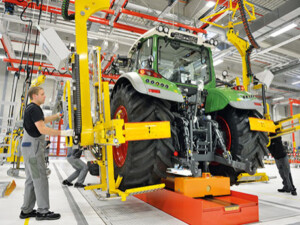 In my previous post I started to show you how Fendt uses the distance between tractors on their assembly line to manage their quite high variability. By changing the distance between parts on the line, you can adjust the takt time for each part on the assembly line, hence the name Variable Takt. But this still leaves a lot of variability, as not all stations will have the same identical workload. In this and the next post I will go deeper into how Fendt manages its variability. This will be good, since Fendt is one of the benchmark plants in the world in handling variability.
In my previous post I started to show you how Fendt uses the distance between tractors on their assembly line to manage their quite high variability. By changing the distance between parts on the line, you can adjust the takt time for each part on the assembly line, hence the name Variable Takt. But this still leaves a lot of variability, as not all stations will have the same identical workload. In this and the next post I will go deeper into how Fendt manages its variability. This will be good, since Fendt is one of the benchmark plants in the world in handling variability.
Variable Distance
As mentioned in my last post, Fendt uses AGVs (that can also extend) to position their products at variable intervals on the assembly line, giving them variable takts. However, this variable takt is the same along the entire assembly line for this one product. Hence, all stations have the same time (i.e., takt) for this one product. This helps to give each product the average time it needs, but it may still be too much for one station and too little for the other one. Therefore, more fine-tuning is needed to make it work. Fendt uses a couple of solutions to handle this variability. They distinguish between global variability (different models) and local variability (different variants of the same model), although a lot of the tools could be used for both. On a side note, this requires all stations to have more space, usually the maximum distance that you have between products.
Mixed Model Sequencing
Mixed Model Sequencing is always an option if you have products with different workloads. A product with a high workload at one station is followed by a product with a low workload at the same station, so that the workers can keep up. For example, a four-door car assembly could be followed by a two-door car assembly if the door assembly station is set up for an average of three doors. This can get rather complicated if you have multiple stations with workload differences. For example, you need to overlap a sequence of two-door cars and four-door cars with a sequence of cars with or without a sunroof, so that the sunroof station also in average can handle the workload. More on this in my long post series on Mixed Model Sequencing.
Fendt does the same, and also tries to sequence its product to have high-workload products at one station followed by low-workload products for the same station. The weighted average cycle time is always below the takt time. Some stations for some products can have less workload, and others more. At Fendt, they allow workload up to 15% above the takt time, as negotiated with the unions. This excess 15% is then followed by a product with less workload so that the workers can catch up again.
Working Ahead
Workers used this, too, to work ahead and do their task already in the preceding station. When I visited, I saw workers who worked one or even two stations ahead of their actual workplace. This is, of course, also possible, and frees up time for later. However, here you need to be careful so that the worker ahead of his station does not cause problems at the preceding stations, for example by being in the way or by assembling something that would have to wait until a previous item is assembled. My feeling is that this working ahead was not so much by design but more due to the time management of the workers.
Separate Line Balancing
Normally, products with such a high difference in workload would benefit from separate assembly lines. Unfortunately, the production volume does not justify multiple assembly lines. But, in a sense, Fendt does have multiple assembly lines, they are just on the same line. They designed virtually different lines and then merged them into one. As a result, the same station could do quite different tasks, depending on which model comes down the line.

This, of course, requires more training of the workforce. In effect, the workers at one station have to be able to do the work of multiple stations that just happen to be on the same spot, depending on which product comes down the line. It has to fit the takt of the model, which—as mentioned above—depends on the distance and hence can vary between models. You may know line balancing. They did separate line balancing for different model (or model groups) on the same line. As a result, the same task may have ended up in different stations for different models. The only restriction was that large and expensive machinery is available only at one station. For example, the installation of the wheels (which require heavy lifting equipment and torquing tools) happens at one station and one station only. This saves investment costs and also reduces the space needed at the line.
Special Task Worker
 Another approach to handle variability both between models and within model variants are “Special Task Workers” (or in German, Sondermonteure). These are workers who move between stations to help with longer and more complicated work. If a product needs more time at a station than what can be handled by other means, these special task workers are assigned to support this station. These special task workers are NOT just called wherever there is a problem (in German, Springer), but are assigned their work depending on the production program.
Another approach to handle variability both between models and within model variants are “Special Task Workers” (or in German, Sondermonteure). These are workers who move between stations to help with longer and more complicated work. If a product needs more time at a station than what can be handled by other means, these special task workers are assigned to support this station. These special task workers are NOT just called wherever there is a problem (in German, Springer), but are assigned their work depending on the production program.
Such an assignment could be due to a different model (global variance), but also due to a variant within one model (local variance). Since they move around a bit and may also have idle times in between, the efficiency of these workers is not terribly high. But they do help to make the overall efficiency of the line better, and that makes it worthwhile. Around 2% of the employees on the shop floor were such special task workers.
As you see, there are a lot of options for how to handle the truly large variability that Fendt encounters with its tractors. But, there is even more. I will continue with even more options on how Fendt handles variability in the next post. Now, go out, handle your own variability, and organize your industry!
Source
The primary book on variable takt is Bebersdorf, Peter, and Arnd Huchzermeier. Variable Takt Principle: Mastering Variance with Limitless Product Individualization. ISBN 978-3-030-87169-7, Springer, 2022. (also available in German) Many thanks to Mr. Bebersdorf for explaining me his approach.
PS: Thanks to Jonathan Folberth for showing me Fendt, and to Peter Bebersdorf for explaining variable takt!




Martin Hofmann 😎